This post may contain affiliate links. Please read our disclosure policy.
This simple, delicious homemade gluten free stir fry sauce is perfect with rice noodles, vegetables, and some protein for the simplest dinner, packed with sweet and savory Asian-style flavors!

Why I love this gluten free stir fry sauce
When we first went gluten free, I missed few things more than gluten free Chinese food recipes. I love gluten free lo mein, sesame chicken and lemon chicken, but there's something about a basic brown stir fry sauce that makes a quick, flavorful dinner so easy to imagine.
The powerhouse behind this recipe is that brown sauce. Add it to rice or rice noodles, vegetables and/or protein, like we do with our gluten free ramen recipe, and you'll have a dinner that satisfies everyone in a hurry.
Ingredients for the sauce

- Miso paste: For tons of umami flavor, I like mellow white miso paste in this recipe. Make sure yours is gluten free by reading the label carefully. I usually use Miso Master brand miso paste, and Trader Joe's also has a convenient gluten free squeeze packet of miso paste, too.
- Dry sherry: A gluten free alternative to more traditional Shaoxing wine, sherry is a cooking wine that adds depth of flavor and some acidity to the sauce. You can also use seasoned mirin, a Japanese rice wine. Cooking sherry has some preservatives, and is less expensive than fine sherry, and I think it's fine here.
- Rice vinegar: You can use seasoned or unseasoned rice vinegar here, as long as it's gluten free, like Marukan brand. Rice vinegar is a byproduct that is produced when making rice wine, and adds a gentle acidity here.
- Gluten free soy sauce: I like Kikkoman brand gluten free soy sauce. Be sure to grab the gluten free bottle, though, as regular soy sauce is made with wheat so it isn't safe on a gluten free diet. You can also use tamari, which has a richer flavor than soy sauce and is usually somewhat less salty. They're both made from soy beans, but can also be made with wheat, so read labels carefully.
- Sesame oil: A smoky oil made from sesame seeds, this provides a rich, full-bodied flavor to your sauce.
- Brown sugar: Adds gentle sweetness to balance the saltiness of the soy sauce and the acidity of the vinegar and wine.
- Onion and powder: These dried aromatics add lots of flavor without any more work. Dried spices are pungent, so you only need a little.
- Cornstarch: Thickens the sauce when it's heated to help it coat the vegetables, protein and/or noodles in your stir fry.
How to make super easy gluten free stir fry sauce
You won't believe how easy it is to make a delicious homemade gluten free stir fry sauce with flavorful gluten free soy sauce or tamari, rice vinegar, toasted sesame oil, a touch of mirin, and a few savory seasonings.
The gluten free stir fry sauce is essentially a basic Asian-style brown sauce, and it can be prepared days ahead of time, sealed in a mason jar and refrigerated. It will separate as it sits, but you can just shake it up and/or whisk it well to redistribute the cornstarch throughout the uncooked sauce.
- In a 2 cup measuring cup or mason jar, place the aromatic powders (garlic and onion) with some of the soy sauce, the thick miso paste and the brown sugar.
- Whisk to combine these first ingredients into a thick paste. Adding some of the soy sauce makes it easier to get the miso paste to combine.
- Add the remaining soy sauce, vinegar, wine, sesame oil, and cornstarch, and whisk to combine.
- The cornstarch should combine fully with the other ingredients, but may settle to the bottom of the mixture if you don't use it immediately.
- Use the mixture right away over noodles, vegetables and protein, or store it in the refrigerator in a sealed jar for up to a week.




Ingredient substitutions and variations
The easy gluten free stir fry recipe below is already gluten free and dairy free, and even vegan, so there aren't too many substitutions to the dish itself. But let's talk about how you can make it your own!
Gluten free stir fry with protein: tofu, chicken, shrimp, beef
The gluten free stir fry recipe below is made with just vegetables, but it also works great with your favorite protein added to it. Try steamed baby shrimp, or thinly sliced beef stir fried in with the vegetables.
You can of course add the thinly sliced chicken we made with gluten free lomein. And the oven-baked tofu in our gluten free ramen noodles recipe is excellent in this dish, too!
Stir fry vegetables
I like making this stir fry recipe with some vegetables that cook down quite a bit, like thinly sliced red onions, stir fried sliced mushrooms (shiitake mushrooms are my favorite since they have a meaty chew), and then some lightly cooked matchsticks-style carrots and snow peas.
But you can add any fresh vegetables you like best. Anything harder that needs to cook for longer, like larger pieces of carrot, broccoli unless it's mostly florets, sliced mushrooms) should go in first. Here are some other vegetable suggestions for your stir fry:
- Sliced bell peppers (lots of colors!), cooked just bite-tender
- Fresh asparagus, chopped roughly
- Broccoli florets (soak up tons of delicious sauce, so add extra!)
- Baby bok choy, to be wilted at the end
Soy free sauce
There is a plenty of soy in the stir fry sauce recipe here, but you should be able to replace it all. In place of tamari, try using soy-free coconut aminos. It's less concentrated in flavor, though, so you'll need more of it.
In place of the gluten free miso paste, you can try using gluten free fish sauce (Thai Kitchen brand is gluten free; read your labels carefully).
Fish sauce has a base of anchovy paste, and adds richness, but not the same thickness as miso. Try adding another tablespoon cornstarch to your stir fry sauce to ensure it thickens enough to coat the gf rice noodles and cooked vegetables.
Alcohol-free
This stir fry recipe calls for mirin, a Japanese cooking wine, or dry cooking sherry. If you're avoiding alcohol completely, try replacing that ingredient with additional rice vinegar. You may need a bit less, so use a clean spoon to taste as you add the additional vinegar.
Cornstarch-free
In place of cornstarch, you can thicken the stir fry sauce with an equal amount of arrowroot, or sweet white rice flour (glutinous rice flour). Superfine white rice flour might even work.

How to prepare gluten free rice noodles
All rice noodles can be cooked by boiling them the traditional way as you would any noodles. That is the method in the cooking instructions on most packages of rice noodles.
If you decide to boil water, add the rice noodles, and then continue to boil the noodles until they're tender (usually less than 3 minutes), be very careful not to overcook the noodles—especially if you're planning to add them into a stir fry like we're doing below.
The thinnest rice noodles, which are typically called “maifun” rice noodles, are the angel hair-like cooked noodles you see in the photos and video in this blog post. I always cook those noodles by soaking them in boiling water for 5 minutes (sometimes less; almost never more).
Whichever way you cook or soften the noodles, be sure to drain the hot or warm water and then rinse the softened noodles in cold water. You can drain the water completely and use the noodles right away.
Alternatively, allow the al-dente, slightly chewy noodles to sit in cold water while you finish cooking your stir fry.
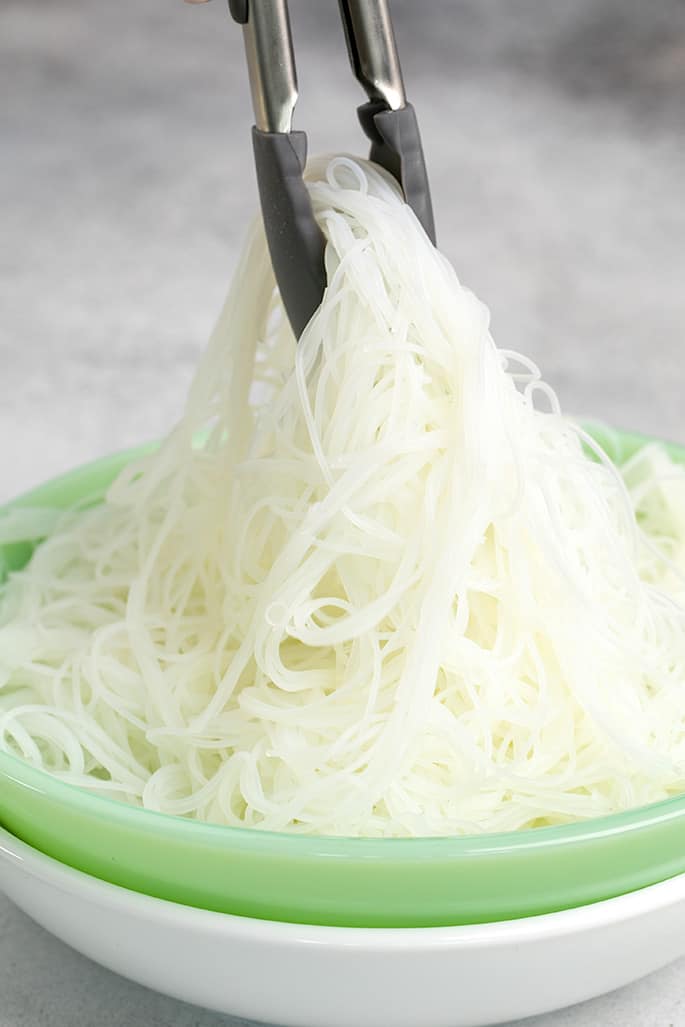
Storage suggestions
Storing stir fry sauce
You can prepare the stir fry sauce itself by whisking together all of the ingredients and placing it in a sealed container in the refrigerator for up to 1 week.
Storing leftover prepared stir fry
If you have any leftover prepared vegetable stir fry, store it in a sealed container at room temperature for a few hours. For longer storage, refrigerate it.
Refrigerated leftovers will dry out a bit, though. You can warm it up in the microwave or in a hot skillet, but try adding a few drops of water if the rice noodles seem to have hardened.
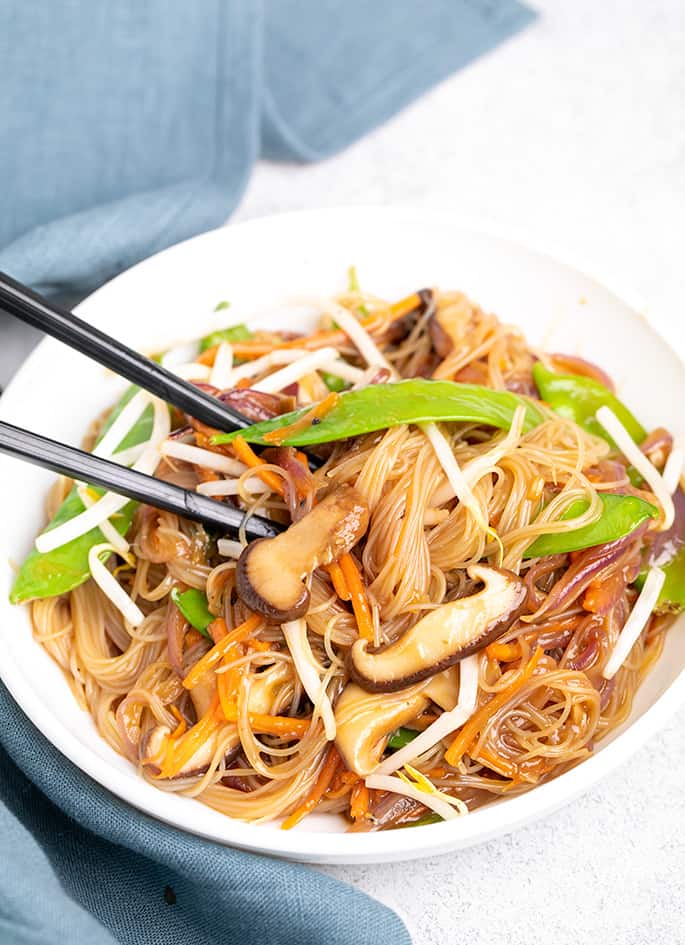
FAQs
Stir fry sauce can be gluten free, like the delicious, sweet and savory gluten free brown sauce we're making here. We use gluten free tamari instead of soy sauce, and thicken our sauce with cornstarch or arrowroot, both gluten free flours.
Be careful about eating just any stir fry sauce, since it might also be made with gluten-containing ingredients, like soy sauce made from wheat. It might also be thickened with a gluten-containing flour.
Yes, almost all rice noodles are gluten free, since plain rice is gluten free. But like always, you have to read your labels to be sure! Since they're usually made simply with rice flour and water, and sometimes with an added starch like tapioca starch or cornstarch, rice noodles tend to be naturally gluten free. They come in so many shapes and sizes, tend to cook so quickly that they can often just be soaked in hot or boiling water rather than boiling them as you would most dried gluten free pasta, and have a lovely, neutral taste.
There are many brands of rice noodles that are safely gluten free. Here are my favorite brands, that are gluten free as of this writing (please always check labels and call the company if you're at all unsure):
Dynasty maifun rice sticks (this is the one I use in the video)
Annie Chun's maifun rice noodles (super thin rice noodles)
A Taste of Thai is a great brand for all shapes and sizes of rice noodles (they have a “vermicelli”/”angel hair” superthin variety, too)
Thai Kitchen is also a great brand for lots of gluten free products, including gf “thin rice noodles”
Lotus Foods makes tasty rice noodles with great texture, but they don't seem to have a maifun variety.
I buy rice noodles all over! The dried variety keeps so well in a cool, dark pantry so I buy a bag or box nearly every time I see them in the grocery store.
I also often buy them online from Vitacost.com and Amazon.com. Just look for the best price, which sometimes I find on Amazon Fresh/Whole Foods, believe it or not!
Noodles that are made with gluten free ingredients, especially gluten free flours and flour blends, are gluten free. Regular, conventional dried pasta is not gluten free. Rice noodles are gluten free!
No, egg noodles aren't gluten free, unless they're made with a GF flour blend like the hearty, rich gluten free egg noodles we make here on the blog.
No, rice noodles are typically made with white rice flour, which is not a low carb food at all. If your rice noodles are made with brown rice flour, they will have some more fiber, but they will still be high in carbohydrates.
Yes! You can prepare the vegetables and sauce, add any cooked protein you like, and serve it over rice, quinoa, or even riced cauliflower.
Rice noodles that have been softened just enough and rinsed to rid them of any excess starch will keep in a sealed container for about 3 hours at room temperature. When prepared properly, they won't even clump like regular cooked noodles will!
Yes! Prepare the sauce according to the recipe instructions, then pour it over cubed skinless boneless chicken breast or cubed extra firm tofu in a sealed zip-top bag. Let it sit in the refrigerator for up to 2 days before cooking the marinated meat or tofu in the sauce in hot skillet or wok.
If you prepare the sauce and place it in a sealed container like a mason jar, it will last in the refrigerator for about 1 week. It will separate, though, so whisk it well or shake the tightly-sealed container vigorously before using it. You can freeze the sauce by pouring it into ice cube molds until frozen solid. Then, pop the cubes out and store them in a zip top bag for up to 2 months.
This recipe makes about 1 1/4 cups of sauce, which is the perfect amount of sauce for 4 servings of a rice or noodle-based stir fry dish with vegetables and/or protein.
Gluten Free Stir Fry Sauce Recipe
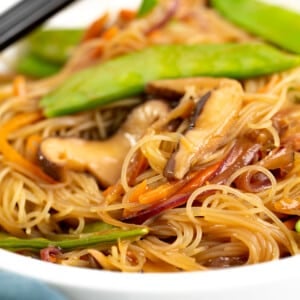
Equipment
- Wok or large skillet
- Kitchen shears
Ingredients
For stir fry sauce
- 6 tablespoons gluten free soy sauce, or tamari
- 1 teaspoon garlic powder
- ½ teaspoon onion powder
- 3 tablespoons mellow white miso paste, Miso Master is gluten free; source carefully
- ¼ cup (55 g) light brown sugar
- 2 tablespoons dry sherry, or gluten free mirin (Japanese rice wine)
- 2 tablespoons rice vinegar
- 1 tablespoon (14 g) toasted sesame oil
- 2 tablespoons (18 g) cornstarch, or arrowroot or sweet white rice flour
- Chopped scallions, fresh or freeze-dried (optional)
For vegetable stir fry
- 8 ounces dried thin gluten free rice noodles, sticks, vermicelli, or maifun
- Boiling water
- 2 tablespoons (28 g) neutral oil, grapeseed, canola, or vegetable
- 1 small red onion, peeled and sliced thin
- 4 ounces fresh mushrooms (shiitake, baby portabella, or white button), cleaned and sliced
- 1 medium carrot, peeled and shredded or cut into small matchsticks
- 4 ounces fresh snow peas
Instructions
Prepare the sauce.
- In a 2 cup measuring cup or glass mason jar, place 2 tablespoons of the gluten free soy sauce or tamari, garlic powder, onion powder, miso paste, and brown sugar, and whisk until very smooth.
- Add the remaining 4 tablespoons of tamari, sherry, rice vinegar, sesame oil, and cornstarch, and whisk to combine completely. This is the basic stir-fry sauce.
- If using freeze-dried scallions, mix them in now, and set the sauce aside. If you’re making the stir fry sauce ahead of time, cover and refrigerate it for up to 1 week.
Prepare the rice noodles.
- Place the thin rice noodles in a medium-size or large pot. Cover the noodles with boiling water, and swish them around a bit to begin to break up the nest, if the noodles are in a nest.
- Allow the noodles to sit in the hot water, uncovered, until mostly tender (about 5 minutes). Drain the hot water, rinse the noodles with cold water and drain again.
- If you’re not planning to use the noodles immediately, let them sit in cold water, covered.
Make the stir fry dish.
- In a nonstick wok or large skillet over medium-high heat, place the cooking oil, the sliced onions and mushrooms. Stir the vegetables to coat them in the oil, cover the wok or skillet, and allow them to cook for 3 minutes or until beginning to soften.
- Add the carrots and snow peas, stir to coat, and cover again. Allow the vegetables to cook for another 2 minutes or until the orange and green vegetables have brightened in color.
- Uncover the skillet, add the prepared stir fry sauce, and stir to combine. Allow the mixture to cook, stirring infrequently, until the sauce begins to thicken (about 3 minutes).
- Drain the prepared rice noodles one final time if they’re soaking in liquid, cut really long noodles in half (if you like) with kitchen shears, and add the prepared noodles to the wok or skillet. Using tongs, toss to coat the noodles completely in the sauce.
- Sprinkle the dish with any fresh, chopped scallions. Divide the dish among 4 serving bowls, and serve hot.
- Store leftovers in a sealed container at room temperature for up to 3 hours. Refrigerate for longer storage, and sprinkle lightly with water before reheating in a warm skillet or the microwave.
Video
Nutrition
Nutrition information is automatically calculated, so should only be used as an approximation.




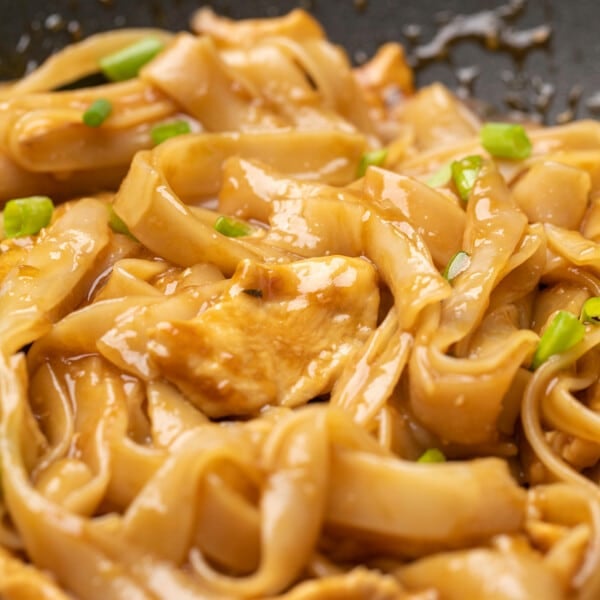
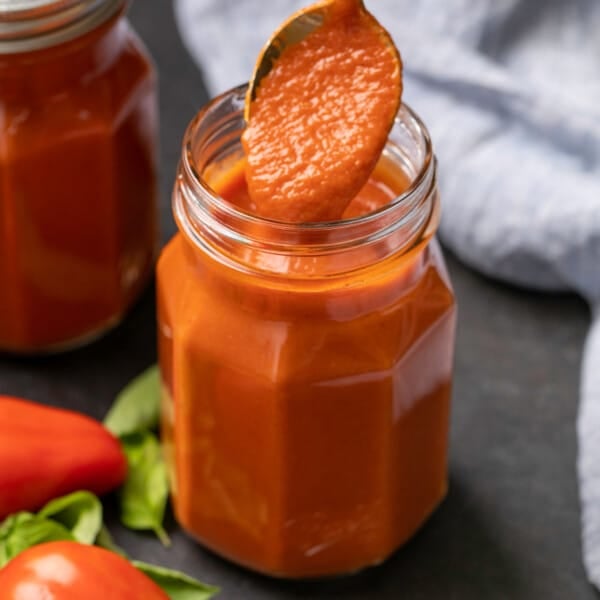










Love your recipes Nicole. Thanks for sharing your knowledge.
Thank you so much for the kind words, Sandra! That’s so lovely of you to say, and you’re very welcome!
I have made it a handful of times now. It’s so good and customizable, makes every meal taste better than takeout. Nicole truly has amazing recipes she works hard on, much appreciated!!
So glad you love the stir fry sauce, Holly. I love that you’re getting so much use out of it, and thank you so much for the kind words!
This stir-fry sauce is wonderful…thanks Nicole. Also wanted to mention that your chocolate chip cookies are loved by family, friends and neighbors. I only use your flour…can’t be beat! Hope the internet is treating you kindly ~ Madelon
Hi, Madelon, thank you so much for the kind words, and for your support in buying Nicole’s Best flour blend! I’m so glad you love the stir fry sauce—and the cookies! Thank you for sharing your experience.
This is a favorite – easy to make and customize, and delicious. Thanks!
You’re so welcome, Don. So glad you love this sauce and yes, customize away!
What is a substitute for miso paste? Thank you in advance
Please see the substitutions heading, under the subheading “Soy free sauce”, Donna.
Wonderful